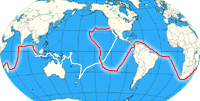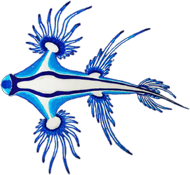The bay of Tijeretas is one of the only places on Galapagos where you can go snorkeling by yourself without a guide. So we take advantage of this and are rewarded with Galapagos Sea lions (Arctocephalus galapagoensis) on our first visit. They especially like Tom and are really showing off in front of the camera. They are clumsy on land but under water they are elegant swimmers. We even see some Galapagos Green Turtles (Chelonia mydas agassisi), which you can encounter almost everywhere. You can watch them eating or swimming around in the bay. On Playa Loberia, southeast of Puerto Baquerizo Moreno, you can see dozens of them eating algae in shallow water, where there also are huge schools of fish.
Our highlight of San Cristobal were definitely our two diving trips to Kicker Rock (Leon Dormido), a steep, split in two rock where it goes down to a depth of 100 m. You won't believe it, but right after her first jump into the water Sonja sees her first hammerhead shark ever - a Scalloped Hammerhead Shark (Sphyrna lewini). Later during the dive we even see a whole school of them swimming by and we still do not believe our eyes. The water is not clear, but the amount of sharks is overwhelming. Next to the hammerhead sharks there are a lot of Galapagos Sharks (Carcharhinus galapagensis), White-tipped Reef Sharks (Triaenodon obesus) as well as Small Black Tip Sharks (Carcharhinus limbatus). Galapagos Green Turtles float through the water, Spotted Eagle Rays (Aetobatus narinari) fly by majestically and Galapagos Sea Lions show us some acrobatic pirouettes. Inside a huge school of fish, which looks like a living and moving wall, you easily lose direction, colorful overgrown walls full of gorgonian and soft corals, as well as zoanthids provide the setting for this dive. In between we find sea stars, pencil sea urchins, sponges and once in a while a small nudibranch – the endemic Galapagos Blue Slug (Tambja mullineri). And as if all this is not enough we even discover some frigate birds displaying their scarlet gular pouches sitting on top of Kicker Rock. A fantastic place which is also suited for snorkeling. A wish came true for us and we can say that we have never seen so many and different sharks in one place. A wonderful feeling!
During our trip from San Cristobal to Puerto Ayora on Santa Cruz we find a lot of different animals in the calm and glassy sea. First we spot a few whales. Because of their blow and diving sequence we think they were Fin whales (Balaenoptera physalus). Unfortunately they do not show us their underside so we could not make sure. Still it was great to see some whales again.
We are surprised by the amount of jumping Mobula Rays on the way. Sometimes even 5 or 6 jump out of the water at the same time. Later we use a stop to go snorkeling with them. After they get interested in us we find out that they are Japanese Devil Rays (Mobula japanica), which grow to a length span of over 3 m and behave similar to manta rays. First they carefully swim around our boat but after a while they get used to us and come closer. So we were able to observe them very closely. They also feed on plankton, which we see a lot of that day.
Beautiful Venus Girdle (Cestum veneri), belonging to the Comb Jellyfish (Ctenophora) and growing up to 1,5 m in length, meander in hundreds through the water. In between a lot of other Comb Jellyfish like the genus Beroe without tentacles. Also Siphonophora can be found. They belong to the order of Hydrozoa and are actually a colony composed of highly specialized individuals, which sting badly. Now we are really looking forward to further trips to explore the underwater world of Galapagos


.jpg)
.jpg)

_and_endemic_green_sea_urchin_(Lytechinus_semituberculatus)(Tijeretas).jpg)

.jpg)
_are_feeding_in_Loberia.jpg)


.jpg)

.jpg)
.jpg)
.jpg)
.jpg)
.jpg)



.jpg)



.jpg)
.jpg)





.jpg)

_on_our_way_to_Santa_Cruz.jpg)


_were_in_the_water_betwenn_the_islands.jpg)

_of_the_open_ocean.jpg)
.JPG)

.JPG)
.jpg)
 >>planned route - join us ...
>>planned route - join us ...